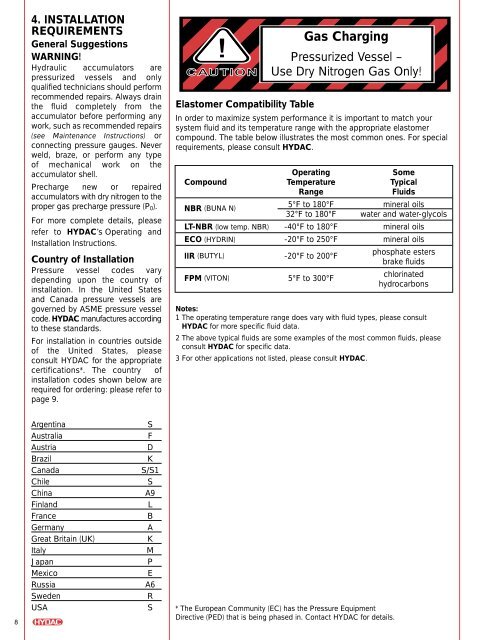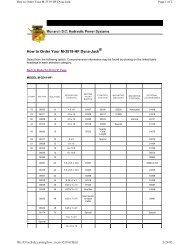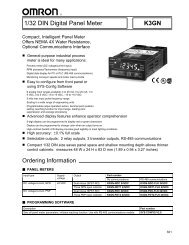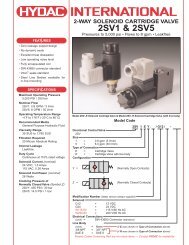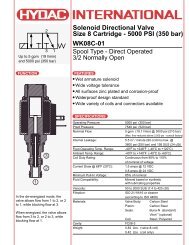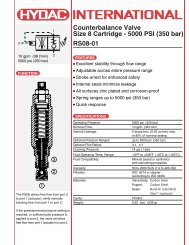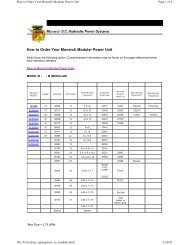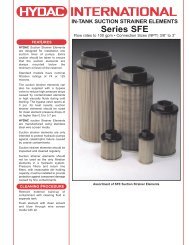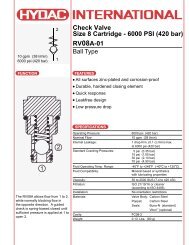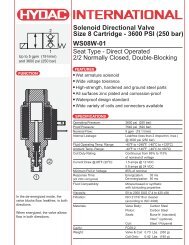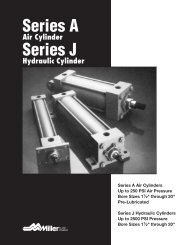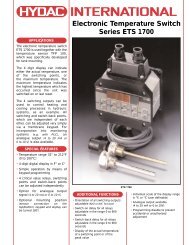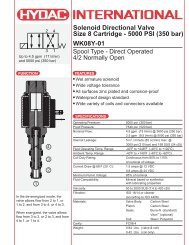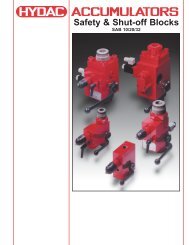Diaphragm Accumulators - Airline Hydraulics
Diaphragm Accumulators - Airline Hydraulics
Diaphragm Accumulators - Airline Hydraulics
Create successful ePaper yourself
Turn your PDF publications into a flip-book with our unique Google optimized e-Paper software.
4. INSTALLATION<br />
REQUIREMENTS<br />
General Suggestions<br />
WARNING!<br />
Hydraulic accumulators are<br />
pressurized vessels and only<br />
qualified technicians should perform<br />
recommended repairs. Always drain<br />
the fluid completely from the<br />
accumulator before performing any<br />
work, such as recommended repairs<br />
(see Maintenance Instructions) or<br />
connecting pressure gauges. Never<br />
weld, braze, or perform any type<br />
of mechanical work on the<br />
accumulator shell.<br />
Precharge new or repaired<br />
accumulators with dry nitrogen to the<br />
proper gas precharge pressure (P 0 ).<br />
For more complete details, please<br />
refer to HYDAC’s Operating and<br />
Installation Instructions.<br />
Country of Installation<br />
Pressure vessel codes vary<br />
depending upon the country of<br />
installation. In the United States<br />
and Canada pressure vessels are<br />
governed by ASME pressure vessel<br />
code. HYDAC manufactures according<br />
to these standards.<br />
For installation in countries outside<br />
of the United States, please<br />
consult HYDAC for the appropriate<br />
certifications*. The country of<br />
installation codes shown below are<br />
required for ordering: please refer to<br />
page 9.<br />
!<br />
CAUTION<br />
Elastomer Compatibility Table<br />
In order to maximize system performance it is important to match your<br />
system fluid and its temperature range with the appropriate elastomer<br />
compound. The table below illustrates the most common ones. For special<br />
requirements, please consult HYDAC.<br />
Operating<br />
Some<br />
Compound Temperature Typical<br />
Range<br />
Fluids<br />
NBR (BUNA N)<br />
5°F to 180°F mineral oils<br />
32°F to 180°F water and water-glycols<br />
LT-NBR (low temp. NBR) -40°F to 180°F mineral oils<br />
ECO (HYDRIN) -20°F to 250°F mineral oils<br />
IIR (BUTYL) -20°F to 200°F<br />
FPM (VITON) 5°F to 300°F<br />
Gas Charging<br />
Pressurized Vessel –<br />
Use Dry Nitrogen Gas Only!<br />
phosphate esters<br />
brake fluids<br />
chlorinated<br />
hydrocarbons<br />
Notes:<br />
1 The operating temperature range does vary with fluid types, please consult<br />
HYDAC for more specific fluid data.<br />
2 The above typical fluids are some examples of the most common fluids, please<br />
consult HYDAC for specific data.<br />
3 For other applications not listed, please consult HYDAC.<br />
8<br />
Argentina<br />
Australia<br />
Austria<br />
Brazil<br />
Canada<br />
Chile<br />
China<br />
Finland<br />
France<br />
Germany<br />
Great Britain (UK)<br />
Italy<br />
Japan<br />
Mexico<br />
Russia<br />
Sweden<br />
USA<br />
S<br />
F<br />
D<br />
K<br />
S/S1<br />
S<br />
A9<br />
L<br />
B<br />
A<br />
K<br />
M<br />
P<br />
E<br />
A6<br />
R<br />
S<br />
* The European Community (EC) has the Pressure Equipment<br />
Directive (PED) that is being phased in. Contact HYDAC for details.


